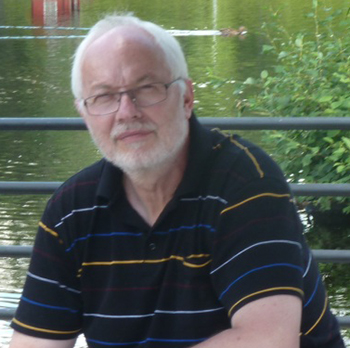
Dénes Szentiványi
One of the members of the 2014 Teaching with Testimony in the 21st Century cohort in Hungary didn’t have any need for new lesson plans for his students, and in fact he didn’t even have a first day of school to prepare for: he’s retired. But he didn’t let that stop him from learning about how testimony can be used to teach students about genocide and tolerance.
Dénes Szentiványi was an engineer in Hungary and Sweden for 35 years and then a high school mathematics teacher in Sweden for over 10 years. After he retired, he thought about how he could spend his sudden abundance of free time meaningfully.
“As I attentively follow politics, it is easy to see that in my old country, Hungary, and sadly even in Sweden, new waves of Nazi and alien-hostile political movements are gaining strength,” Szentiványi said. He therefore became interested in organizations that try to counteract these movements, and was led to USC Shoah Foundation.
Szentiványi has a deep personal connection to the Holocaust. His mother, hiding in a small apartment alongside the Danube River in Budapest, witnessed the mass shootings in the river of Jewish men, women and children during the Holocaust. Throughout his life, he has read Holocaust literature and visited concentration camps and memorials. He, like so many others, has always wanted to try to understand the incomprehensible, he said.
“There is an expression I read somewhere that got stuck in my mind. It accurately expresses how I feel: ‘The poison of Auschwitz has imbibed me,’” Szentiványi said.
So, when he found out about USC Shoah Foundation’s Teaching with Testimony in the 21st Century professional development program for educators, he wanted to participate. The two-year program introduces local educators to the methodology of teaching with the testimonies in the Visual History Archive in an initial weeklong session. Each participant creates his or her own original lesson plan, which they pilot in their classroom and then present to the cohort at a follow-up session the next year.
Because Szentiványi lives in Sweden and is not a practicing teacher, he acted as an observer only. But he still attended both the initial program in 2014 and the follow-up session in 2015 and covered his own travel costs.
He said it was an honor to observe Teaching with Testimony, and he found the program very professional and impactful. He felt that it broadened his knowledge of the Holocaust and equipped the participants with valuable pedagogical strategies for teaching it to today’s students.
He was also very impressed by the lessons that the other teachers presented at the follow-up session and the enthusiasm of everyone involved, especially those who have no personal or family connection to the Holocaust or antisemitism but participated, he felt, “due to their humanity and empathy.” Szentiványi believes that at least one teacher from every school in Hungary should be required to complete the Teaching with Testimony program, for the benefit of teaching of history and for all of Hungarian society.
“For me personally, it was a fantastic experience to participate in the course,” Szentiványi said. “I have met new people who have the same aim as I do, namely to hinder that the horrors of the last century repeat itself.”